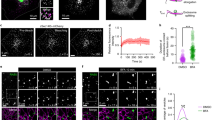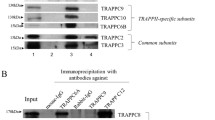Abstract
ER-to-Golgi protein transport involves transport vesicles of which formation is initiated by assembly of Sar1. The assembly of Sar1 is suppressed by protein kinase inhibitor H89, suggesting that ER-to-Golgi transport is regulated progressively by H89 sensitive kinase. ER-resident Gi2 protein suppresses vesicle formation with inhibition of Sar1 assembly. This study examined whether these promotion and suppression of vesicle transport share the same signal pathway, by examining the effects of Gi/o protein activator mastoparan 7 (Mp-7) and H89 on Sar1 and Sec23 recruitment onto microsomes. In a cell-free system for Sar1 translocation assay, GTPγS addition induced the translocation of Sar1 onto microsomes. Mp-7 and H89 decreased the Sar1 translocation. Double treatment of Mp-7 and H89 strongly decreased Sar1 translocation. In single and double treatments, however, Gi/o protein inactivator pertussis toxin (IAP) partially restored the suppressive effect of Mp-7, but had not any effect on H89-induced effect. Then, the assembly of Sec23 onto the microsome was also increased by the addition of GTPγS. Sec23 translocation was decreased by Mp-7 and/or H89 treatment and recovered by IAP pretreatment except for H89 single treatment, similarly to Sar1 translocation in each treatment. Inhibitory effects of H89 and Mp-7on ER-to-Golgi vesicle transport by H89 or Mp-7 were also confirmed in a cell culture system by BFA-dispersion and BFA-reconstruction experiments. These findings indicate that promotion and suppression of ER-to-Golgi vesicle transport are modulated through separate signal pathways.



Similar content being viewed by others
References
Barlowe C, Orci L, Yeung T, Hosobuchi M, Hamamoto S, Salama N, Rexach MF, Ravazzola M, Amherdt M, Schekman R (1994) COPII: a membrane coat formed by sec proteins that drive vesicle budding from the endoplasmic reticulum. Cell 77:895–907
Matsuoka K, Orci L, Amherdt M, Bednarek SY, Hamamoto S, Schekman R, Yeung T (1998) COPII-coated vesicle formation reconstituted with purified coat proteins and chemically defined liposomes. Cell 93:263–275
Barlowe C, Schekman R (1993) SEC12 encodes a guanine-nucleotide-exchange factor essential for transport vesicle budding from the ER. Nature 365:347–349
Bi X, Corpina RA, Goldberg J (2002) Structure of the Sec23/24–Sar1 pre-budding complex of the COPII vesicle coat. Nature 419:271–277
Huang M, Weissman JT, Beraud-Dufour S, Luan P, Wang C, Chen W, Aridor M, Wilson IA, Balch WE (2001) Crystal structure of Sar1-GDP at 1.7 A resolution and the role of the NH2 terminus in ER export. J Cell Biol 155:937–948
Balch WE, McCaffery JM, Plutner H, Farquhar MG (1994) Vesicular stomatitis virus glycoprotein is sorted and concentrated during export from the endoplasmic reticulum. Cell 76:841–852
Springer S, Schekman R (1998) Nucleation of COPII vesicular coat complex by endoplasmic reticulum to Golgi vesicle SNAREs. Science 281:698–700
Yoshihisa T, Barlowe C, Schekman R (1993) Requirement for a GTPase-activating protein in vesicle budding from the endoplasmic reticulum. Science 259:1466–1468
Davidson HW, McGowan CH, Balch WE (1992) Evidence for the regulation of exocytic transport by protein phosphorylation. J Cell Biol 116:1343–1355
Davidson HW, Balch WE (1993) Differential inhibition of multiple vesicular transport steps between the endoplasmic reticulum and trans Golgi network. J Biol Chem 268:4216–4226
Aridor M, Balch WE (2000) Kinase signaling initiates coat complex II (COP II) recruitment and export from the mammalian endoplasmic reticulum. J Biol Chem 275:35673–35676
Nakagawa H, Miyazaki S, Abe T, Umadome H, Tanaka K, Nishimura K, Komori M, Matsuo S (2011) H89 sensitive kinase regulates the translocation of Sar1 onto the ER membrane through phosphorylation of ER-coupled β-tubulin. Int J Biochem Cell Biol 43:423–430
Balch WE (1992) From G minor to G major. Curr Biol 2:157–160
Barr FA, Leyte A, Huttner WB (1992) Trimeric G proteins and vesicle formation. Trends Cell Biol 2:91–94
Stow JL, de Almeida JB, Narula N, Holtzman EJ, Ercolani L, Ausiello DA (1991) A heterotrimeric G protein, G alpha i-3, on Golgi membranes regulates the secretion of a heparan sulfate proteoglycan in LLC-PK1 epithelial cells. J Cell Biol 114:1113–1124
Beckers CJ, Balch WE (1989) Calcium and GTP: essential components in vesicular trafficking between the endoplasmic reticulum and Golgi apparatus. J Cell Biol 108:1245–1256
Robinson MS, Kreis TE (1992) Recruitment of coat proteins onto Golgi membranes in intact and permeabilized cells: effects of brefeldin A and G protein activators. Cell 69:129–138
Matsuo S, Kiyomiya K, Kurebe M (1998) Mechanism of toxic action of fluoride in dental fluorosis: whether trimeric G proteins participate in the disturbance of intracellular transport of secretory ameloblast exposed to fluoride. Arch Toxicol 72:798–806
Matsuo S, Nakagawa H, Kiyomiya K, Kurebe M (2000) Fluoride-induced ultrastructural changes in exocrine pancreas cells of rats: fluoride disrupts the export of zymogens from the rough endoplasmic reticulum (rER). Arch Toxicol 73:611–617
Ito M, Nakagawa H, Okada T, Miyazaki S, Matssuo S (2009) ER-stress caused by accumulated intracisternal granules activates autophagy through a different signal pathway from unfolded protein response in expcrine pancreas cells of rats exposed to fluoride. Arch Toxicol 83:151–159
Nakagawa H, Umadome H, Miyazaki S, Tanaka K, Nishimura K, Komori M, Matsuo S (2011) ER-resodent Gi2 protein controls Sar1 translocation onto the ER during budding of transport vesicles. J Cell Biochem 112:2250–2256
Rowe T, Aridor M, McCaffery JM, Plutner H, Nuoffer C, Balch WE (1996) COPII vesicles derived from mammalian endoplasmic reticulum microsomes recruit COPI. J Cell Biol 135:895–911
Aridor M, Bannykh SI, Rowe T, Balch WE (1995) Sequential coupling between COPII and COPI vesicle coats in endoplasmic reticulum to Golgi transport. J Cell Biol 131:875–893
Sonoda H, Okada T, Jahangeer S, Nakamura S (2007) Requirement of phospholipase D for ilimaquinone-induced Golgi membrane fragmentation. J Biol Chem 282:34085–34092
Du X, Kristiana I, Wong J, Brown AJ (2006) Involvement of Akt in ER-to-Golgi transport of SCAP/SREBP: a link between a key cell proliferative pathway and membrane synthesis. Mol Biol Cell 17:2735–2745
Nagaya H, Wada I, Jia Y, Kanoh H (2002) Diacylglycerol kinase delta suppresses ER-to-Golgi traffic via its SAM and PH domains. Mol Biol Cell 13:302–316
Palmer KJ, Konkel JE, Stephens DJ (2005) PCTAIRE protein kinases interact directly with the COPII complex and modulate secretory cargo transport. J Cell Sci 118:3839–3847
Bigay J, Deterre P, Pfister C, Chabre M (1987) Fluoride complexes of aluminum or beryllium act on G-proteins as reversibly bound analogues of the gamma phosphate of GTP. EMBO J 6:2907–2913
Sternweis PC, Gilman AG (1982) Aluminum: a requirement for activation of the regulatory component of adenylate cyclase by fluoride. Proc Natl Acad Sci USA 79:4888–4891
Mittal R, Ahmdian MR, Goody RS, Wittinghofer A (1996) Formation of a transition-state analog of the Ras GTPase reaction by Ras-GDP, tetrafluoroaluminate, and GTPase-activating proteins. Science 273:115–117
Weidman PJ, Winter WM (1994) The G protein-activating peptide, mastoparan, and the synthetic NH2-terminal ARF peptide, ARFp13, inhibit in vitro Golgi transport by irreversibly damaging membranes. J Cell Biol 27:1815–1827
Amin RH, Chen HQ, Veluthakal R, Silver RB, Li J, Li G, Kowluru A (2003) Mastoparan-induced insulin secretion from insulin-secreting betaTC3 and INS-1 cells: evidence for its regulation by Rho subfamily of G proteins. Endocrinology 144:4508–4518
Fourest-Lieuvin A, Peris L, Gache V, Garcia-Saez I, Juillan-Binard C, Lantez V, Job D (2006) Microtubule regulation in mitosis: tubulin phosphorylation by the cyclin-dependent kinase Cdk1. Mol Biol Cell 17:1041–1050
Limas CJ, Limas C (1983) Involvement of microtubules in the isoproterenol-induced ‘down’-regulation of myocardial beta-adrenergic receptors. Biochim Biophys Acta 735:181–184
Kohtz DS, Puszkin S (1989) Phosphorylation of tubulin by casein kinase II regulates its binding to a neuronal protein (NP 185) associated with brain coated vesicles. J Neurochem 52:285–295
Donaldson JG, Klausner RD (1994) ARF; a key regulatory switch in membrane traffic and organelle structure. Curr Opin Cell Biol 6:527–532
Puri S, Linstedt AD (2003) Capacity of the Golgi apparatus for Biogenesis from the endoplasmic reticulum. Mol Biol Cell 14:5011–5018
Siddhanta A, Backer JM, Shiekds D (2000) Inhibition of phosphatidic acid synthesis alters the structure of the Golgi apparatus and inhibits secretion in endocrine cells. J Biol Chem 275:12023–12031
Author information
Authors and Affiliations
Corresponding author
Rights and permissions
About this article
Cite this article
Nakagawa, H., Ishizaki, M., Miyazaki, S. et al. Sar1 translocation onto the ER-membrane for vesicle budding has different pathways for promotion and suppression of ER-to-Golgi transport mediated through H89-sensitive kinase and ER-resident G protein. Mol Cell Biochem 366, 175–182 (2012). https://doi.org/10.1007/s11010-012-1295-x
Received:
Accepted:
Published:
Issue Date:
DOI: https://doi.org/10.1007/s11010-012-1295-x




